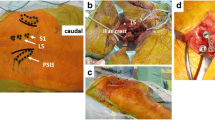Abstract
Incomplete sacroiliac joint injuries are often associated with external rotation and extension deformities on the injured hemipelvis. To appropriately correct this deformity, an oblique reduction force from caudal to cranial and lateral to medial is helpful. These injuries are often associated with traumatic disruption of the pubic symphysis. However, in injuries without traumatic disruption to the pubic symphysis, a two-pin oblique anterior external fixator can be used to obtain and maintain reduction of the sacroiliac joint, while percutaneous fixation is subsequently placed. Through a small case series and three specific patient examples, we demonstrate that the oblique anterior external fixator frame is a simple and effective strategy with the reduction and stabilization process of these multiplanar hemipelvis deformities.




Similar content being viewed by others
References
Tucker MC, Nork SE, Simonian PT, Routt ML Jr (2000) Simple anterior pelvic external fixation. J Trauma 49:989–994. https://doi.org/10.1097/00005373-200012000-00002
Wojahn RD, Gardner MJ (2019) Fixation of anterior pelvic ring injuries. J Am Acad Orthop Surg 27:667–676. https://doi.org/10.5435/jaaos-d-17-00839
Banerjee R, Verwiebe E, Cooper W (2010) Indirect reduction of bilateral tilt fractures using a supra-acetabular pelvic external fixator. J Trauma 69:227–230. https://doi.org/10.1097/TA.0b013e3181c452ce
Bellabarba C, Ricci WM, Bolhofner BR (2006) Distraction external fixation in lateral compression pelvic fractures. J Orthop Trauma 20:S7-14
Lee C, Sciadini M (2018) The use of external fixation for the management of the unstable anterior pelvic ring. J Orthop Trauma 32(Suppl 6):S14–S17. https://doi.org/10.1097/bot.0000000000001251
Gardner MJ, Nork SE (2007) Stabilization of unstable pelvic fractures with supraacetabular compression external fixation. J Orthop Trauma 21:269–273. https://doi.org/10.1097/BOT.0b013e318030e3e4
Kim WY, Hearn TC, Seleem O, Mahalingam E, Stephen D, Tile M (1999) Effect of pin location on stability of pelvic external fixation. Clin Orthop Relat Res. https://doi.org/10.1097/00003086-199904000-00030
Abdelfattah A, Moed BR (2014) Ligamentous contributions to pelvic stability in a rotationally unstable open-book injury: a cadaver study. Injury 45:1599–1603. https://doi.org/10.1016/j.injury.2014.05.026
Ebraheim NA, Mekhail AO, Checroun AJ, Georgiadis GM (1997) Vertical displacement of the symphysis pubis in unilateral open book pelvic injury. Am J Orthop (Belle Mead NJ) 26:502–506
Hefzy MS, Ebraheim N, Mekhail A, Caruntu D, Lin H, Yeasting R (2003) Kinematics of the human pelvis following open book injury. Med Eng Phys 25:259–274. https://doi.org/10.1016/s1350-4533(02)00196-0
Sagi HC, Coniglione FM, Stanford JH (2011) Examination under anesthetic for occult pelvic ring instability. J Orthop Trauma 25:529–536. https://doi.org/10.1097/BOT.0b013e31822b02ae
Jäckle K, Spering C, Seitz MT, Höller S, Meier MP, Hahn FM et al (2022) Anatomic reduction of the sacroiliac joint in unstable pelvic ring injuries and its correlation with functional outcome. Eur J Trauma Emerg Surg 48:1491–1498. https://doi.org/10.1007/s00068-020-01504-z
Pastor T, Tiziani S, Kasper CD, Pape HC, Osterhoff G (2019) Quality of reduction correlates with clinical outcome in pelvic ring fractures. Injury 50:1223–1226. https://doi.org/10.1016/j.injury.2019.04.015
Evans AR, Routt ML Jr, Nork SE, Krieg JC (2012) Oblique distraction external pelvic fixation. J Orthop Trauma 26:322–326. https://doi.org/10.1097/BOT.0b013e31821d01dd
Bishop JA, Routt ML Jr (2012) Osseous fixation pathways in pelvic and acetabular fracture surgery: osteology, radiology, and clinical applications. J Trauma Acute Care Surg 72:1502–1509. https://doi.org/10.1097/TA.0b013e318246efe5
Schwarz AM, Hohenberger GM, Grechenig P, Kerner A, Gänsslen A, Staresinic M et al (2021) The 2–2–2–20–20 concept for supraacetabular schanz screw insertion without additional radiography. Injury 52(Suppl 5):S58-s62. https://doi.org/10.1016/j.injury.2020.07.039
von Glinski A, Frieler S, Blecher R, Mayo K, Lee CB, Yilmaz E et al (2020) The iliac pillar—definition of an osseous fixation pathway for internal and external fixation. Orthop Traumatol Surg Res 106:869–875. https://doi.org/10.1016/j.otsr.2020.04.009
Shaath MK, Avilucea FR, Routt MLC Jr (2021) Transverse and transverse-variant acetabular fractures with ipsilateral sacroiliac joint injuries: a technical note for reduction and stabilization. Injury 52:1083–1088. https://doi.org/10.1016/j.injury.2020.12.011
Phen HM, Wise B, Thompson D, Nascone J, Boissonneault A, Maceroli M (2020) Fully threaded sacroiliac lag screws have higher load to failure when compared to partially threaded screws: a biomechanical study. J Clin Orthop Trauma 11:1151–1157. https://doi.org/10.1016/j.jcot.2020.10.035
Gardner MJ, Kendoff D, Ostermeier S, Citak M, Hüfner T, Krettek C et al (2007) Sacroiliac joint compression using an anterior pelvic compressor: a mechanical study in synthetic bone. J Orthop Trauma 21:435–441. https://doi.org/10.1097/BOT.0b013e318126bb8e
Funding
This study received no funding.
Author information
Authors and Affiliations
Corresponding author
Ethics declarations
Conflict of interest
The authors report no conflicts of interest specifically relevant to this study.
Ethical standards
The authors of this manuscript confirm that all aspects of the study are in compliance with institutional and national ethical standards. No funding was received for this study. The authors report no conflicts of interest specifically relevant to this study. Institutional review board ethical approval was obtained for this study. Informed consent was obtained for all appropriate patients.
Additional information
Publisher's Note
Springer Nature remains neutral with regard to jurisdictional claims in published maps and institutional affiliations.
Rights and permissions
Springer Nature or its licensor (e.g. a society or other partner) holds exclusive rights to this article under a publishing agreement with the author(s) or other rightsholder(s); author self-archiving of the accepted manuscript version of this article is solely governed by the terms of such publishing agreement and applicable law.
About this article
Cite this article
Haase, D.R., Saiz, A.M., Warner, S.J. et al. Oblique anterior pelvic external fixator for intraoperative reduction of rotationally unstable pelvic ring injuries. Eur J Orthop Surg Traumatol (2023). https://doi.org/10.1007/s00590-023-03648-1
Received:
Accepted:
Published:
DOI: https://doi.org/10.1007/s00590-023-03648-1




